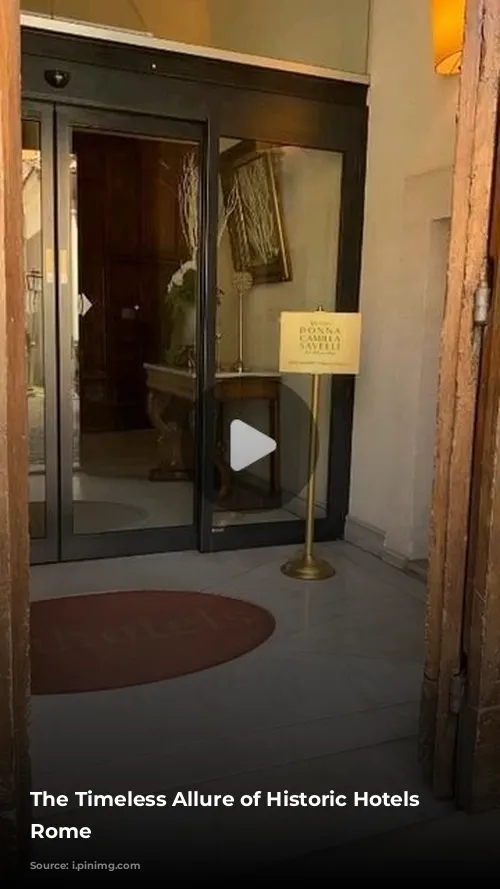Rome, a city steeped in history, boasts an abundance of enchanting hotels that whisper tales of bygone eras. These havens of luxury, elegance, and style are not merely places to rest your head but portals to a rich tapestry of the past. From the first Renaissance inns to grand Parisian-inspired hotels, their walls have witnessed the passage of history, echoing with the footsteps of artists, writers, royalty, and revolutionaries.
A Legacy of Elegance and Glamour
The charm of these historic hotels lies in their ability to transport guests to another time. Their interiors, often adorned with intricate details like hand-painted frescoes, marble floors, and antique furniture, evoke a sense of grandeur and sophistication. These are not just buildings; they are living repositories of stories, each room a silent witness to the lives that have unfolded within them.
The Albergo del Sole, Rome’s oldest hotel, is a testament to this rich legacy. Its history stretches back to 1467, when it welcomed the soldiers of Emperor Frederick III of Habsburg. Over the centuries, it has hosted luminaries like poet Ludovico Ariosto, composer Pietro Mascagni, and even the enigmatic Count of Cagliostro. Today, guests can still marvel at its 18th-century frescoes, stroll through its flower-filled garden, and feel a palpable connection to the past.
A short walk away stands the Grand Hotel de la Minerve, Rome’s first grand hotel. Its suites bear the names of renowned guests like Stendhal, Herman Melville, and George Sand, each room a tribute to the literary giants who once graced its halls. The building’s elegant lines and refined decorative details, created by Rinaldo Rinaldi, Antonio Canova’s apprentice, contribute to the hotel’s timeless charm.
The Grand Hotel Plaza, with its monumental architecture and panoramic terraces, is another jewel in Rome’s crown. It was a meeting point for the elite of the time, hosting figures like Princes Umberto and Margherita of Savoy, directors Luchino Visconti and Federico Fellini, and the Empress Carlota of Mexico.
Located near Porta del Popolo, the Hotel de Russie stands as a testament to the grand lifestyle of the 19th century. Known as “a paradise on earth” by French poet Jean Cocteau, it hosted a who’s who of European royalty, earning the nickname “Hotel of the Kings.” Its secret garden, a masterpiece designed by Giuseppe Valadier, is a hidden oasis within the bustling city.
The Hotel Locarno, a refined Art Nouveau gem, encapsulates the artistic spirit of the 1920s and 1930s. Inaugurated in 1925, it quickly became a hub for artists, actors, and intellectuals, attracting luminaries like Jean-Michel Basquiat and Jorge Luis Borges.
Perched atop the Spanish Steps, the Hotel Hassler Villa Medici, founded in 1893 by Swiss hotelier Albert Hassler, has played host to countless notables, including the Kennedy family, Prince Rainier of Monaco, and Grace Kelly. Its elegant interiors and breathtaking views offer a glimpse into the glamorous world of Rome’s social elite.
The Sina Bernini Bristol, with its impressive terrace overlooking Piazza Barberini, offers a panoramic vista reminiscent of Paolo Sorrentino’s acclaimed film “The Great Beauty.” Throughout its history, it has welcomed emperors, princes, and industrial tycoons, including the Rockefellers and the Vanderbildts, who sought refuge from the harsh winters in Rome’s warm embrace.
The Dolce Vita of Via Veneto
Via Veneto, one of Rome’s most iconic streets, has witnessed a vibrant evolution, from its Belle Époque origins to its iconic status in the 1950s and 1960s, immortalized by Federico Fellini’s “La Dolce Vita.”
The Majestic, one of the first hotels built on the street in 1889, exudes an air of timeless elegance. Architect Gaetano Koch’s unique design, featuring a “piano-like” layout, has captivated guests since the 1920s, attracting royalty, princes, and Hollywood stars.
The nearby Palace Hotel, built in 1900, was originally intended for ambassadors. After serving as the American Embassy Library during the postwar era, it reopened in the 1990s as the Ambasciatori Palace, preserving its original grandeur and Neo-Renaissance charm.
The Grand Hotel Palace, designed by Marcello Piacentini, embodies the transition from Art Nouveau to Art Deco. Its elegant interiors, adorned with stuccos, crystal chandeliers, and frescoes by Venetian artist Guido Cadorin, transport guests to a bygone era of luxury and refinement.
These historic hotels are more than just places to stay; they are living testaments to the rich tapestry of Rome’s history. They offer a glimpse into the lives of those who came before us, inviting guests to step back in time and experience the enduring charm of the Eternal City.
